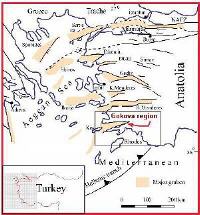
Western Turkey |
 Research on Geoelectric Structure of the Gökova Graben, Aegean Region
Research on Geoelectric Structure of the Gökova Graben, Aegean Region
The Menderes massif with its northeasterly oriented elliptical shape has a significant imprint on the geological
evolution of western Anatolia. In this region, we attempted to care to the Gökova graben
in southwestern Anatolia,
since it is not clearly known that whether this region has a graben construction. Our main goal in this study is to
obtain the geoelectrical structure of the inland area of the Gökova rift and to illustrate the possible faults that
control the construction of Gökova Graben, using the geoelectrical resistivity method. The 3-dimensional
resistivity picture and the two-dimensional geoelectric models indicate that the tectonic structure is comparatively
complex, and that the structural pattern is distrupted by numerous fault zones. Interpretation of geoelectrical structure
pointed to that the inland area of the Gökova rift has an asymmetric graben structure as observed in both the Gediz
and Büyük Menderes grabens.
|